Jury sends notepublished at 18:21 BST 30 June
Sean Combs and both legal teams have returned to the courtroom after the jury sent a note.
They are reading it now.
The judge has told jurors to continue deliberating after they reached a partial verdict in Sean "Diddy" Combs's criminal trial
The jury has reached a verdict on four of the five counts Diddy faces, but are unable to on the fifth - the racketeering conspiracy charge
Court has now adjourned for Tuesday, but according to Judge Arun Subramanian's instructions, jurors will return for more deliberations on Wednesday
If convicted on the racketeering charge, Combs faces up to life in prison
Warning: This page contains details some readers may find distressing
The 12-member jury has heard from 34 witnesses over nearly two months, including ex-girlfriends, former employees of Combs, male escorts and federal agents
Combs, 55, is charged with sex trafficking, racketeering conspiracy and transportation to engage in prostitution. He denies all charges
Watch: The BBC's Nomia Iqbal explains racketeering as jurors divided on charge
Edited by Brandon Livesay in New York, with Sakshi Venkatraman and Madeline Halpert reporting from court
Sean Combs and both legal teams have returned to the courtroom after the jury sent a note.
They are reading it now.
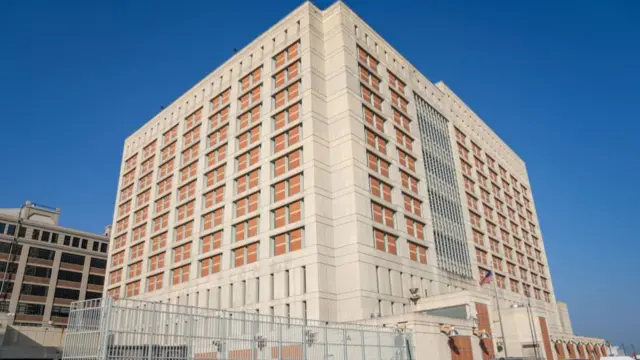 Image source, Theodore Parisienne for New York Daily News/Tribune News Service via Getty Images
Image source, Theodore Parisienne for New York Daily News/Tribune News Service via Getty ImagesSean Combs is currently in a holding cell at the courthouse while he waits for the jury to deliver a verdict.
The hip hop mogul has been behind bars since his September 2024 arrest, held in the Metropolitan Detention Centre in Brooklyn, New York.
Known as the MDC, it’s had a host of notorious inmates.
Combs has reportedly shared the same unit as cryptocurrency entrepreneur Sam Bankman-Fried, who once ran a company worth billions but was convicted on multiple counts of fraud.
And previously it has been home to rapper R Kelly and Jeffrey Epstein’s associate Ghislane Maxwell.
 Nada Tawfik
Nada Tawfik
New York correspondent
This Manhattan courthouse has pulled back the curtain on the private life of one of hip hop’s biggest icons.
The mogul and producer admits that he beat his partners - had a drug problem - and that he enjoyed so-called "freak offs" - or prolonged sexual encounters between his girlfriends and male prostitutes.
But Sean "Diddy" Combs insists the sex was consensual. So is he guilty of running a criminal enterprise and sex trafficking?
The jury will need to weigh the evidence to decide if he’s just a flawed individual being unfairly targeted by overzealous prosecutors and women after money. Or if he’s someone who used his vast wealth, power and influence to manipulate, trap and force women to fulfil his sexual desires.
There’s video and photo evidence - text messages - hotel and financial records - flight logs. But ultimately this case hinges on who the jury believes.
Cassie Ventura and Jane spoke in harrowing detail about the physical toll the "freak offs" and drugs took on their bodies - how Diddy controlled every aspect of their life - and his threats including blackmail.
Diddy didn’t testify and jurors can’t hold that against him, because the burden is on the government to prove its case. But his lawyers said the women were free to leave at any time - and when they did - nothing happened.
The defence claimed the women were just as enthusiastic about the “swinger” lifestyle. So - was there a power imbalance? Was every "freak off" consensual - or did they eventually turn into sex trafficking when the women told him they didn’t want to do them anymore?
Those are all important questions in this case.
Here's what the jury in Diddy's sex trafficking trial is considering
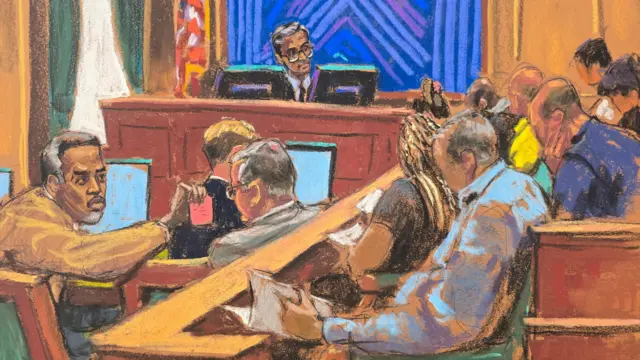 Image source, Jane Rosenberg / Reuters
Image source, Jane Rosenberg / ReutersMembers of the media are not allowed to take cameras into the Manhattan courthouse, so we rely on artists to show you what it looks like inside.
Jane Rosenberg has just shared this latest sketch.
It shows Sean "Diddy" Combs passing a note to his attorney Marc Agnifilo as Judge Arun Subramanian gives legal instructions to the jury.
The judge has granted a request from the defence team for Sean Combs to be allowed several books as we wait for a verdict. He will be in a holding cell until that moment happens.
We don't know how long deliberations might take, but the judge told jurors they have as long as they need to come to a unanimous verdict.
 Sakshi Venkatraman
Sakshi Venkatraman
Reporting from court
Judge Arun Subramanian has been full of personality throughout this trial, and he cemented that today in his farewell to the jurors.
He thanked them for their time and said he would have someone give each juror his personal contact if they have questions about their service or anything else.
"If you want a tour of the courthouse, it’s the least I can do," he says.
 Sakshi Venkatraman
Sakshi Venkatraman
Reporting from court
The jurors will have an extensive verdict sheet to fill out.
Not only do they have to determine if Combs is guilty or not guilty on all five counts, they also have to decide if the prosecution met the burden of proof for each offence under the racketeering charge (arson, kidnapping, bribery, and several others).
When they’re done deliberating, they will fill out that sheet and the foreperson will inform the court.
Each charge and offence will be read out in open court along with each of their verdicts.
 Sakshi Venkatraman
Sakshi Venkatraman
Reporting from court
Before heading to the jury room to decide the case, Judge Arun Subramanian gave them a sincere thanks and final instructions.
The 12 jurors will now elect a foreperson - that’s who will deliver the verdict in open court.
During deliberations, they will stop if even one person leaves the room.
Alternate jurors will be allowed to go home, but have to be reachable until deliberation has ended in case they need to tap in.
The judge read out more of the standard rules - no talking to anyone about the case, no reading the news or doing research, and don’t let feelings or sympathies interfere.
The jury is now deliberating.
The judge tells them they can take as long as they want each day. They can stay beyond the 17:00 EDT (22:00 BST) time that court usually finishes, if they wish to.
 Madeline Halpert
Madeline Halpert
Reporting from court
The charges against Combs have now all been read to the jury.
Now we’re hearing from the judge on a few other details, such as expert witnesses, people who did not testify, and intoxication.
The judge tells jurors that intoxication is not a defence for committing crimes, but it may impact intent to commit certain crimes, including racketeering.
Jurors can either conclude Combs was too intoxicated to have the intent to commit racketeering - or that he had intent even when he was intoxicated.
This is an argument we heard often from Combs' lawyers, that his violence was fuelled by drugs and jealousy, not by a goal of sex trafficking.
 Madeline Halpert
Madeline Halpert
Reporting from court
We are now "in the home stretch" of the instructions to jurors, the judge tells the court.
After many pages of racketeering charges, he quickly summarises the sex trafficking counts against Combs. These involve Combs' ex-girlfriends Cassie Ventura and Jane (who testified under a pseudonym).
The judge reminds jurors of the three conditions they need to find Combs guilty:
Jurors are told to consider the background of the alleged victim - their education, intelligence etc - and how that may have played a role in their choice to participate in a sex act.
 Sakshi Venkatraman
Sakshi Venkatraman
Reporting from court
The judge just wrapped up explaining the racketeering charge.
One element he mentioned is what constitutes drug distribution under racketeering.
The judge told the jury the amount of drugs is irrelevant. The jury must find that at least two people agreed to distribute a drug from one person to another.
 Madeline Halpert
Madeline Halpert
Reporting from court
We spent most of the nearly two-month trial listening to the different crimes that prosecutors allege Combs committed through the racketeering act.
For instance, they allege he committed kidnapping by forcing Cassie Ventura to stay hidden in a hotel to hide her bruises after he beat her up.
They say he kidnapped his former employer Capricorn Clark to make her take a lie detector test over several days under the threat of "being thrown in the East River".
Arson is also alleged. Prosecutors called rapper Kid Cudi to the stand to testify about a time they allege Combs firebombed his Porsche out of jealously over his relationship with Ventura.
There’s also allegations of forced labour. Prosecutors called Combs' former employee Mia to the stand to tell jurors about how she could not leave Combs’ house when she was working for him, and worked incredibly long hours.
 Madeline Halpert
Madeline Halpert
Reporting from court
It’s a slow Monday morning as we listen to the judge’s instructions.
Several people in the overflow room have fallen asleep at times, including one man who is audibly snoring. And a woman in here is knitting.
The judge is still carefully walking through the racketeering charge, including the eight different types of crimes that prosecutors allege he committed.
This includes witness tampering, forced labour, kidnapping, bribery and drug distribution.
Combs is relatively still in his chair as the judge gets into the heart of the charges.
 Sakshi Venkatraman
Sakshi Venkatraman
Reporting from court
Racketeering is a complicated charge, and the judge is carefully talking the jury through the different components.
Racketeering conspiracy is an explicit or implicit agreement between two or more people to commit a crime. It doesn’t have to be a formal agreement, the judge says.
He reminds the jury about what the government has labelled the "Combs enterprise". That is the core group of people that are alleged to have conspired to commit crimes.
To be convicted, Combs would have had to knowingly and wilfully been a member of the alleged conspiracy. The jury would need to find that Combs agreed with at least one more person in the alleged group to commit at least two of crimes he is charged with. Those crimes would need to have happened within 10 years of each other.
If convicted of racketeering, Combs could face up to life in prison.
Judge Arun Subramanian is taking the jury through the five counts Sean "Diddy" Combs has been charged with:
The judge instructs the jury that the indictment itself is not evidence. He also says if they determine Combs’ guilt or innocence on one of the counts, that shouldn’t impact how they view the other counts.
 Sakshi Venkatraman
Sakshi Venkatraman
Reporting from court
Combs’ six adult children and his mother are all here, sitting behind the defendant in their regular seats.
They’re shifting around as the judge gives his instructions, and passing notes to each other on a pad of paper.
Sitting with his lawyers, Combs is quite active today. He is moving around in his chair, taking his glasses on and off, and passing notes to his lawyer Marc Agnifilo.
He often glances towards the jury box.
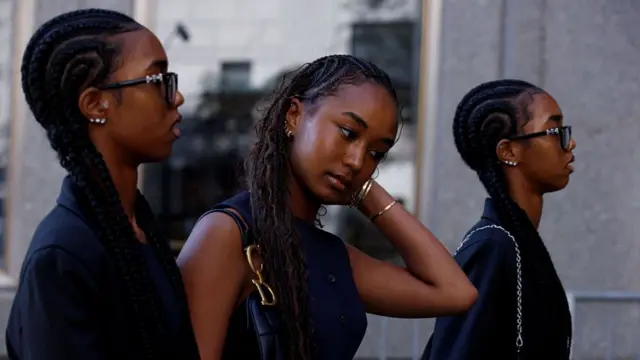 Image source, Leonardo Munoz / AFP via Getty Images
Image source, Leonardo Munoz / AFP via Getty ImagesJessie Combs (L), Chance Combs (C) and Lila Combs (R), daughters of Sean Combs, arrive at court on Monday morning
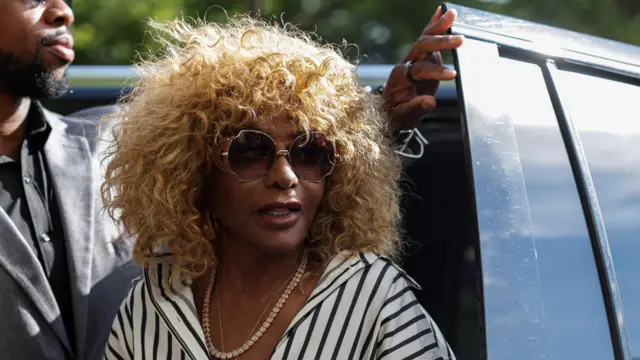 Image source, Eduardo Munoz / Reuters
Image source, Eduardo Munoz / ReutersJanice Combs, mother of Sean "Diddy" Combs
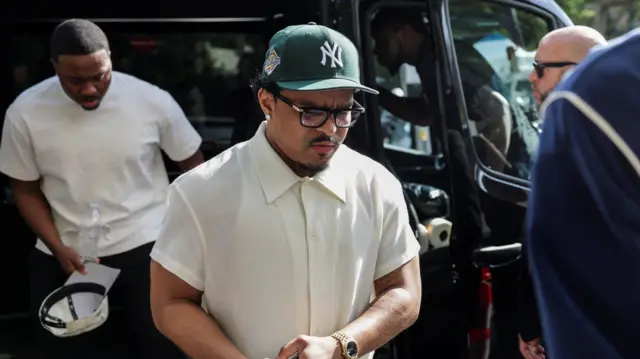 Image source, Eduardo Munoz / Reuters
Image source, Eduardo Munoz / ReutersJustin Combs, son of Sean "Diddy" Combs
 Madeline Halpert
Madeline Halpert
Reporting from court
The judge reminds the 12 New Yorkers that it is the government that has the burden of proving Combs’ guilt beyond a reasonable doubt.
What is a reasonable doubt?
He explains that it is a doubt a reasonable person has after carefully reviewing and weighing all the evidence.
It’s not proof beyond any possible doubt, he says. He tells the jurors they will be weighing two kinds of evidence - direct evidence such as testimony, and circumstantial evidence, such as inferences. The jurors will also weigh whether witnesses who testified in the trial - more than 30 of them - were believable or credible, and how important their testimony is.
"There is no magic formula" for determining credibility, the judge says.
 Madeline Halpert
Madeline Halpert
Reporting from court
We have just begun hearing instructions from Judge Arun Subramanian to jurors.
Combs is in court wearing his usual cream sweater, sometimes leaning back in his chair. At times he has his head down while the judge reads the instructions to jurors.
His family is here once again, seated together in a row behind him.
The judge begins by reminding the jurors that they are the "sole and exclusive judges of the facts".
They have to determine a verdict without bias or prejudice to either of the parties involved.